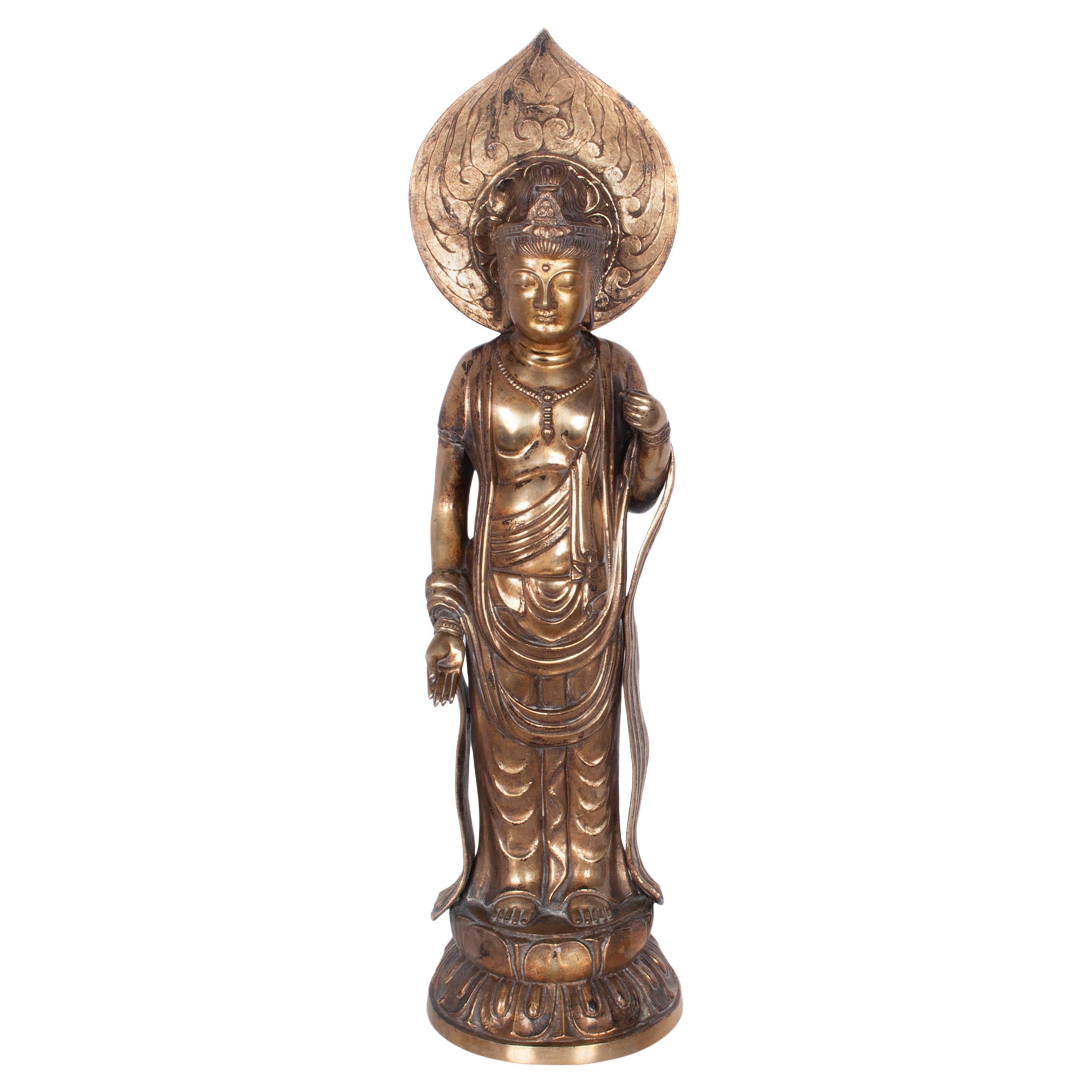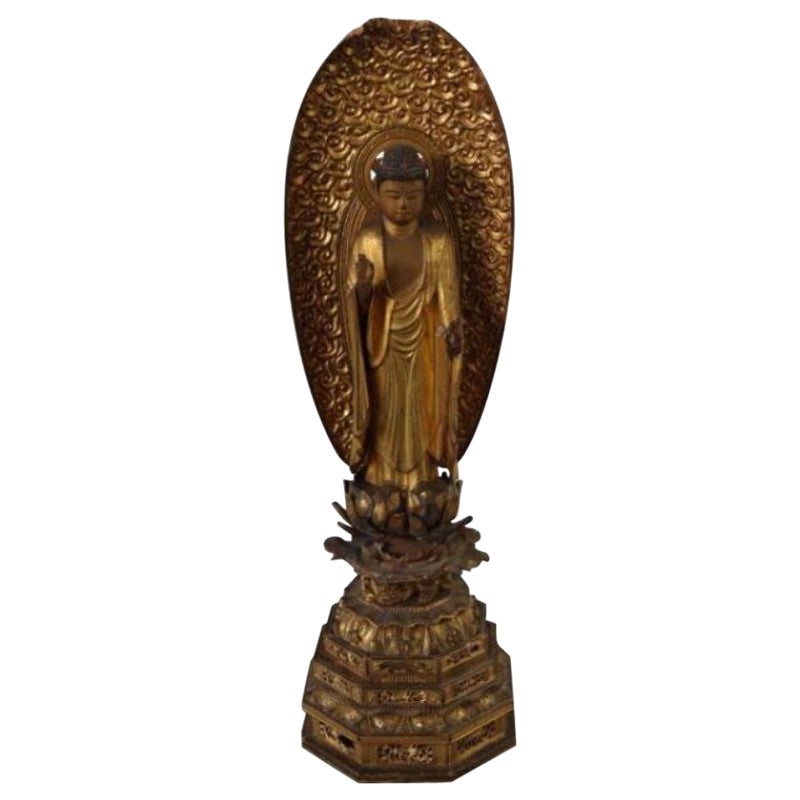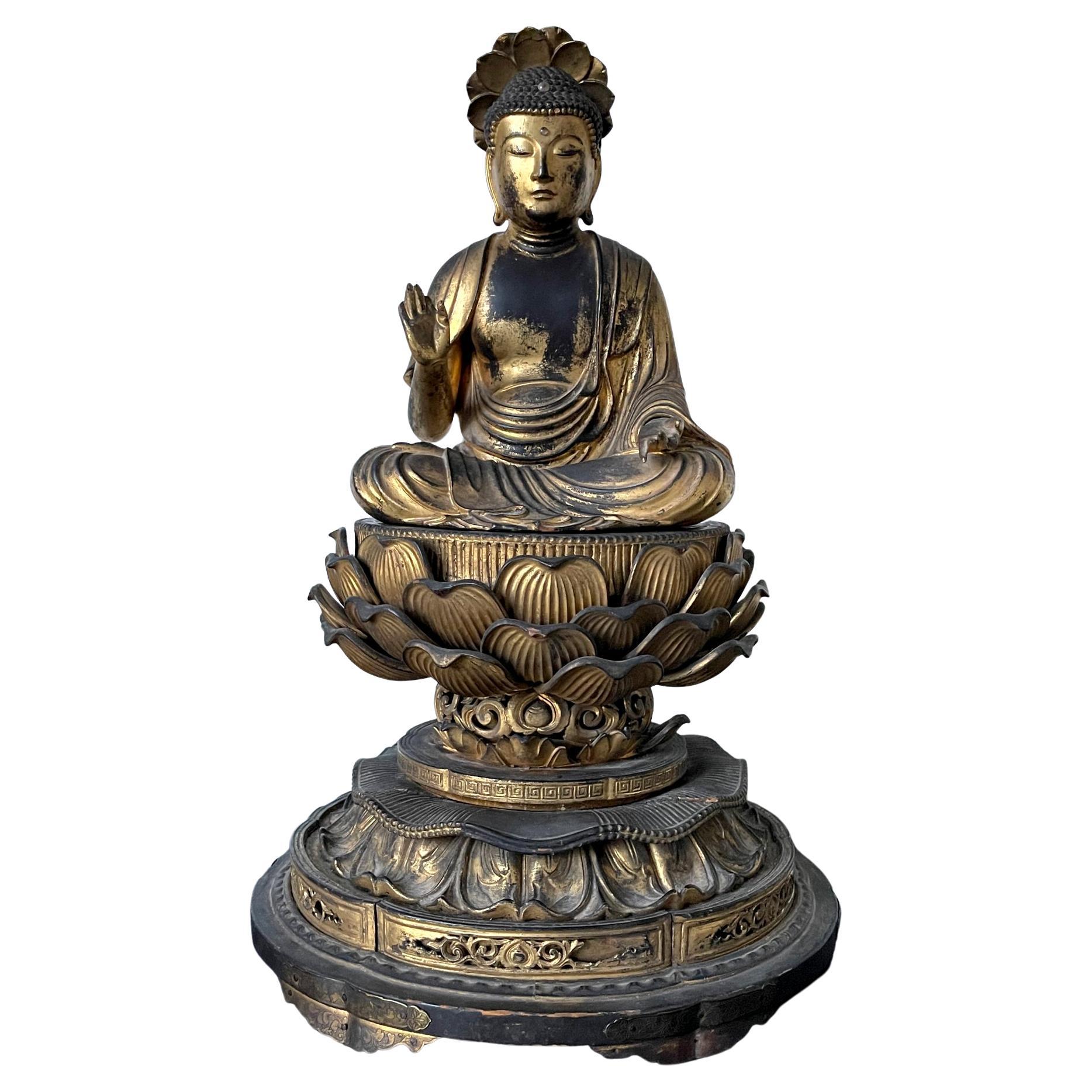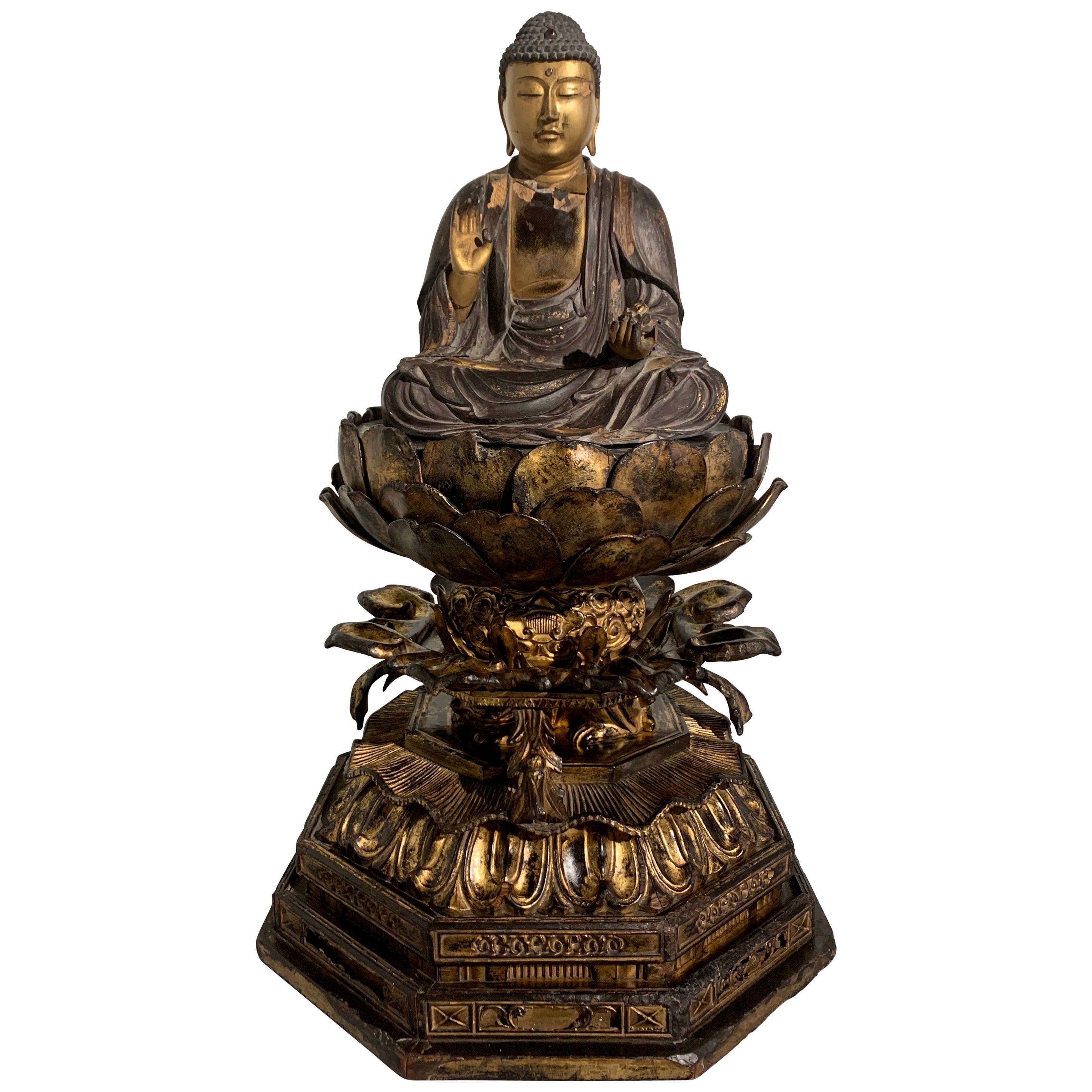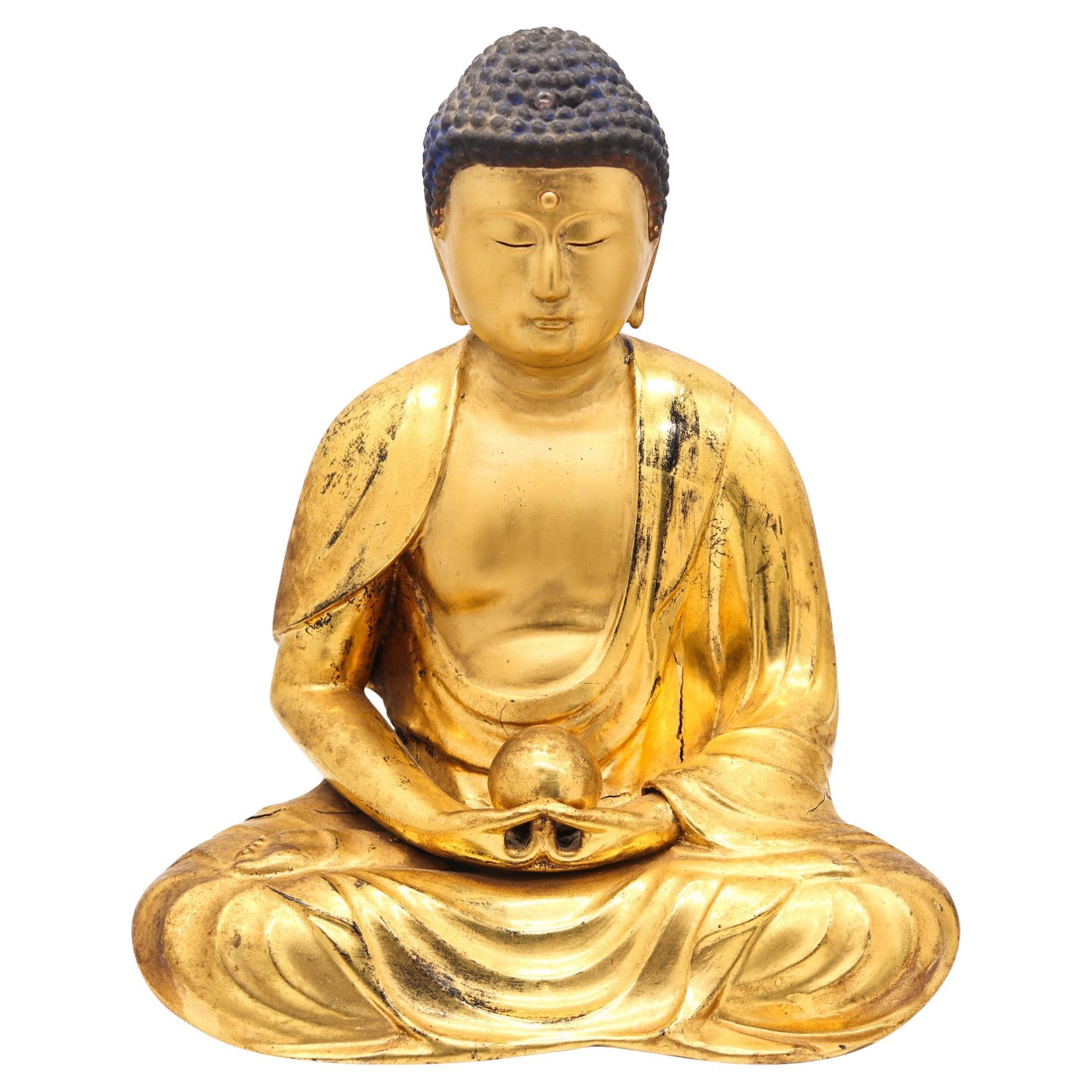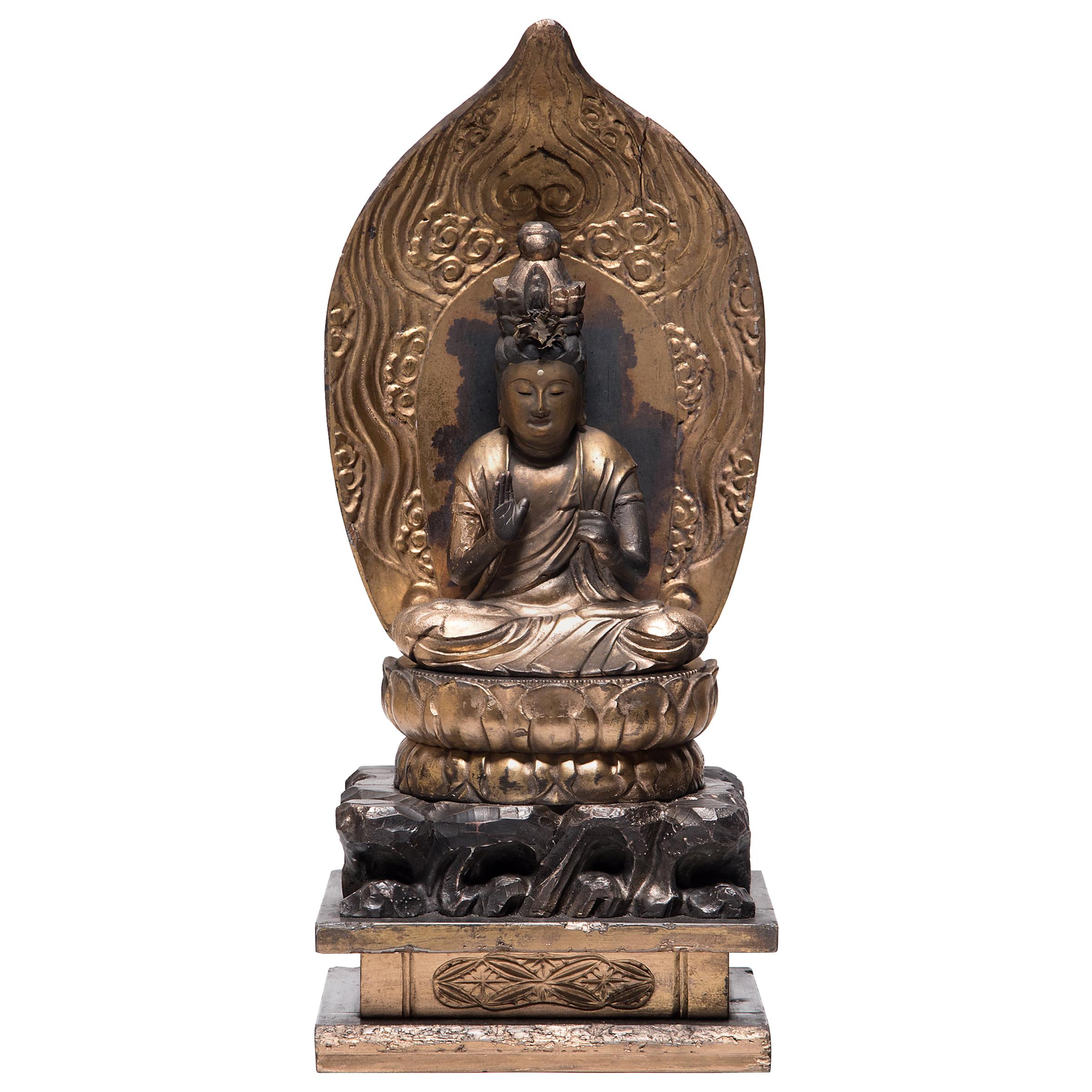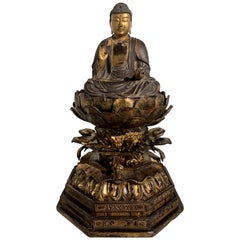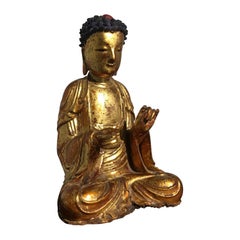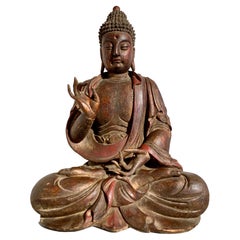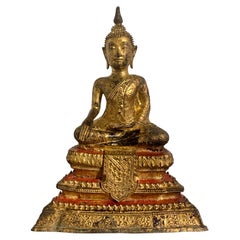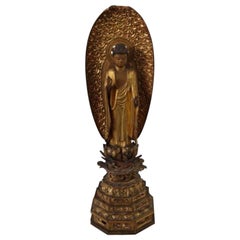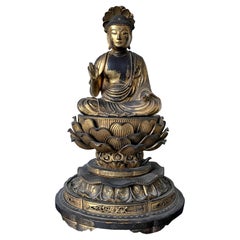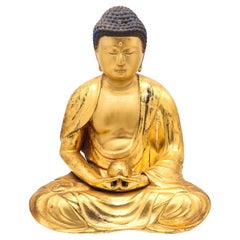Items Similar to Japanese Standing Gilt Buddha, Amida Nyorai, Edo Period, 18th century, Japan
Want more images or videos?
Request additional images or videos from the seller
1 of 18
Japanese Standing Gilt Buddha, Amida Nyorai, Edo Period, 18th century, Japan
$15,000
£11,381.65
€13,013.90
CA$20,950.93
A$23,294.59
CHF 12,163.15
MX$283,551.84
NOK 155,196.47
SEK 145,411.67
DKK 97,125.17
Shipping
Retrieving quote...The 1stDibs Promise:
Authenticity Guarantee,
Money-Back Guarantee,
24-Hour Cancellation
About the Item
An exquisite Japanese carved hinoki and gilt lacquered standing figure of Amida Nyorai, Amitabha Buddha, Edo Period, 18th century, Japan.
The spectacular fully gold gilt figure of Amida Nyorai is portrayed standing upon an elaborate lotus pedestal with individually carved petals painted in green and blue mineral pigments with gilt highlights. The open lotus is supported by a charming blue painted shishi on an ornate fluted and undulating base. This figure of Amida Nyorai is luminous, covered all over in a rich and bright gold lacquer.
Amida Nyorai, Amitabha Buddha, the Buddha of Infinite Light, is dressed in loose fitting robes that drape elegantly around his robust figure, leaving his chest and the top of his belly exposed.
He holds his hands in raigo-in, the mudra of welcoming, performed with the thumb touching the index finger. This gesture is used to remind worshipers of Amida Buddha's promise to welcome them into his Western Paradise, or Pure Land when they pass from this realm. It is believed Amida himself descends from the Pure Land to guide the faithful to his paradise.
His full, round face is calm and expressive. He looks out from heavily lidded and downcast inset and painted rock crystal eyes. High arched brows, a broad, flat nose and plump lips set in a complete the face. The forehead with a hole that once held a now-missing urna. Narrow, s-shaped ears with long earlobes and blue painted hair arranged in the traditional neat rows of curls over a pronounced ushnisha frame the face.
This figure of Amida Nyorai is carved from hinoki (cypress) wood, gessoed, lacquered, and gilt. The gilding worn in some areas, revealing the black lacquer below.
Provenance: The estate of T. Boone Pickens, Dallas, TX
- Dimensions:Height: 20.5 in (52.07 cm)Width: 8.5 in (21.59 cm)Depth: 7.5 in (19.05 cm)
- Style:Edo (Of the Period)
- Materials and Techniques:
- Place of Origin:
- Period:
- Date of Manufacture:18th century
- Condition:Repaired: Both hands and one foot with evidence of glue repair. Wear consistent with age and use. Minor losses. Minor structural damages. Minor fading. Losses to the fingertips and tips of the lotus petals. Missing the crystal urna in the forehead. The mandorla missing. Slight flaking and loss to the lacquer, as seen in photos.
- Seller Location:Austin, TX
- Reference Number:1stDibs: LU894734734212
About the Seller
5.0
Platinum Seller
Premium sellers with a 4.7+ rating and 24-hour response times
Established in 2001
1stDibs seller since 2010
345 sales on 1stDibs
Typical response time: <1 hour
- ShippingRetrieving quote...Shipping from: Austin, TX
- Return Policy
Authenticity Guarantee
In the unlikely event there’s an issue with an item’s authenticity, contact us within 1 year for a full refund. DetailsMoney-Back Guarantee
If your item is not as described, is damaged in transit, or does not arrive, contact us within 7 days for a full refund. Details24-Hour Cancellation
You have a 24-hour grace period in which to reconsider your purchase, with no questions asked.Vetted Professional Sellers
Our world-class sellers must adhere to strict standards for service and quality, maintaining the integrity of our listings.Price-Match Guarantee
If you find that a seller listed the same item for a lower price elsewhere, we’ll match it.Trusted Global Delivery
Our best-in-class carrier network provides specialized shipping options worldwide, including custom delivery.More From This Seller
View AllJapanese Giltwood Medicine Buddha, Yakushi Nyorai, Muromachi Period 16th Century
Located in Austin, TX
A striking Japanese late Muromachi Period (1333-1573) lacquered and giltwood figure of Yakushi Nyorai, the Medicine Buddha, seated upon an elaborate car...
Category
Antique 16th Century Japanese Edo Sculptures and Carvings
Materials
Rock Crystal
Korean Carved and Giltwood Buddha, Joseon Dynasty, 19th Century
Located in Austin, TX
A sublime and well carved Korean lacquered and gilt wood figure of Amitabha Buddha (Amita Bul), Joseon Dynasty, early 19th century, Korea.
The Budd...
Category
Antique Early 19th Century Korean Sculptures and Carvings
Materials
Wood
Large Chinese Carved and Lacquered Buddha, Qing Dynasty, 19th Century
Located in Austin, TX
A large and magnificent near life-sized Chinese carved and lacquered wood figure of a Buddha, Qing Dynasty, 19th century or earlier, southern China.
The figure likely represents one of the Five Tathagatas, also known as Dhyani Buddhas or Wisdom Buddhas. More specifically, either Amitabha or Amoghasiddhi. Amitabha is the Buddha of infinite light, and represents the wisdom of observation and recognition. Amoghasiddhi is the Buddha of accomplishment, and represents the wisdom of perfected practices. The size and scale of the Buddha indicates it was made for temple worship.
The large Buddha is portrayed seated in vajrasana, or full lotus position, with the soles of both feet facing up. His elegant hands, with impossibly long and slender fingers, perform shuni mudra, the gesture of bestowing patience. His right arm is bent at the elbow, the right hand raised to heart level. The left arm resting gently in his lap, the left hand at navel level.
The Buddha is dressed in voluminous robes that wrap around his shoulders and body, and tied at the waist. The heavy fabric draping and pooling elegantly all around his robust body. His broad chest and right arm exposed.
The Buddha's face is both solemn and beatific - his expression seeming to change depending on the angle of view. The most notable feature of his face is the large urna to the center of his forehead, set between a pair of painted, high arching brows over heavily lidded almond shaped eyes. A strong nose is set above a small mouth pursed in an ever so slight smile. Long pendulous earlobes touch his shoulders.
The Buddha's hair arranged in the typical fashion, with "spikes" representing tight curls. A prominent ushnisha rises from the crown of his head, covered by more hair, and topped with a rounded protuberance.
The Buddha is constructed from several blocks of wood, joined, carved and lacquered a deep red-brown with gold flecks...
Category
Antique 19th Century Chinese Qing Sculptures and Carvings
Materials
Wood
Thai Gilt Bronze Buddha Marvijaya, Rattanakosin Period, 19th Century, Thailand
Located in Austin, TX
A lovely Thai lacquered and gilt cast bronze figure of the historical Buddha, Shakyamuni, portrayed in Maravijaya, Rattanakosin Period, early to mid 19th century, Thailand.
The B...
Category
Antique Mid-19th Century Thai Sculptures and Carvings
Materials
Bronze
Chinese Ming Dynasty Lacquered and Gilt Bronze Bodhisattva, 17th Century
Located in Austin, TX
Chinese late Ming dynasty bronze figure of the Bodhisattva Avalokiteshvara, also known as Guanyin (Quan Yin, Kwan Yin, Kuan Yin), 17th century, China
The figure well cast in two ...
Category
Antique Mid-17th Century Chinese Ming Sculptures and Carvings
Materials
Bronze
Burmese Ava Period Carved, Lacquered and Giltwood Buddha, Late 18th Century
Located in Austin, TX
A sublime and rare late 18th century Burmese Ava period carved, lacquered and gilt Buddha. The historical Buddha, Shakyamuni, is portrayed in bhumisparsha mudra, the gesture of calling the Earth to witness, commemorating the moment the Buddha reached enlightenment.
The Buddha is dressed in patchwork...
Category
Antique Late 18th Century Burmese Sculptures and Carvings
Materials
Wood
You May Also Like
Antique 18th Century Japanese Edo Gilt Bronze Kannon Buddha Statue Figure 1750
Located in Portland, OR
A fine & rare large antique 18th century Japanese Edo period gilt bronze Kannon statue, circa 1750.
This finely cast gilded bronze statue represents the Japanese Bodhisattva of Merc...
Category
Antique 18th Century Japanese Edo Sculptures and Carvings
Materials
Bronze
Golden Wooden Statue of Buddha, 19th Century
Located in Marseille, FR
Golden wooden statue of Buddha from the 19th century standing in a lotus flower with a height of 73 cm and a width of 24 cm. Remarkable patina. Some gaps.
Additional information:
...
Category
Antique 19th Century Sculptures and Carvings
Materials
Wood
Japanese Antique Gilt Wood Amitabha Buddha on Loctus Throne Statue
Located in Atlanta, GA
A Japanese carved wood Amitabha (Amida) Buddha statue with residual gold leafed surface circa 19th century (late Edo period). The buddha is seated in the padmasana position on an elevated double lotus throne, under a small lotus halo canopy. His right hand is held in abhaya mudra which means fearlessness in Sanskrit. The mudra symbolizes protection, peace, and fearless. His left hand gently resting on his thigh. Dressed in a flowing robe with open chest, the statue showcases a classic iconography found prominently in Japanese Buddhism art during Edo to Meiji period, characterized by the double lotus throne and a particularly serene meditative facial expression, highlighted by inset gemstones...
Category
Antique 19th Century Japanese Edo Sculptures and Carvings
Materials
Gold Leaf
JAPAN Edo Period 1825 Seated Buddha Sculpture In Solid Gilded Carved Wood
Located in Miami, FL
A seated Buddha sculpture in gilt carved wood from the Edo Period.
This is a superbly refined carved wooden figure of a seated Buddha with fabulous pure gold gilt. The sculpture has...
Category
Antique 1820s Japanese Edo Sculptures and Carvings
Materials
Gold
Japanese Gilt Seated Kannon Figure, circa 1850
Located in Chicago, IL
Intricately carved and finished with gilt black lacquer, this seated figure depicts the bodhisattva Guanyin, known in Japanese Buddhism as Kannon. Described as the "Buddha of Infinite Compassion," Kannon is the embodiment of mercy and makes himself available to all who call upon him with all their mind.
Kannon is depicted here seated in diamond position upon a double lotus plinth, set above a stepped base. He is dressed in gracefully draped robes and wears a tall crown bearing a minuscule figure of Amida, the Buddha of Infinite Light. He has a serene expression of calm and holds his right hand in the abhaya mudra, a gesture of comfort, blessing, and protection. Backed by a magnificent leaf-form nimbus, this Kannon figure...
Category
Antique Mid-19th Century Japanese Edo Sculptures and Carvings
Materials
Wood, Lacquer
Tibetan Bronze Standing Gilt Bronze Buddha Offering Protection
Located in West Palm Beach, FL
Tibetan bronze standing gilt bronze buddha offering protection
China, 20th century
A fine example, the Buddha standing on lotus base with the "no fear" abhaya mudra, the figure is ...
Category
20th Century Chinese Chinese Export Sculptures and Carvings
Materials
Bronze
$1,000 Sale Price
20% Off
More Ways To Browse
18th Century Gilt Frame
18th Century Wood Carving
Crystal Japanese
Black Japanese Chest
Antique Cypress
Antique Cypress Furniture
18th Century Buddha
Japanese Joinery
Antique Japanese Wood Carvings
Gilted Buddha
Japanese Buddha
Japanese Wood Figure
Green Buddha
18th Century Asian Wood Carvings
Lacquered Buddha
Buddha Figures
Buddha Blue
Lacquer Chest Japan
